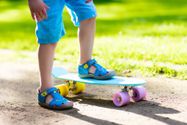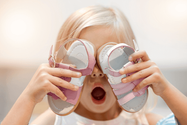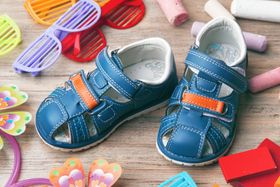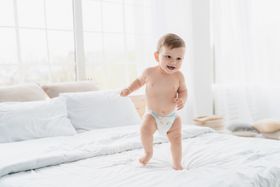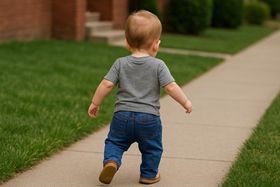How Many Pairs of Shoes Does Your Toddler Truly Need?
Toddler Shoe Essentials: Find out the ideal number of shoe pairs for your little one's growing feet
Published February 19, 2025
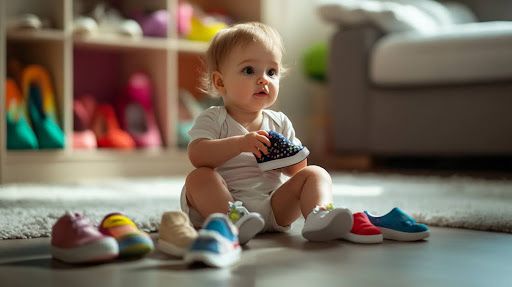
As parents, we want the best for our little ones, especially when it comes to their developing feet. But with so many adorable tiny shoes on the market, it's easy to go overboard. So, how many pairs does your toddler need?
Let's walk through this practical question with some foot-friendly advice.
» Choose quality over quantity. Explore our durable kids' shoes today
How Many Shoes Do Kids Need?
It's recommended that children have at least 3–4 pairs of shoes to meet their various needs. Having multiple pairs allows for rotation, which is essential for foot health as it prevents the growth of bacteria and fungi, reduces odour, and extends the shoes' lifespan.
Different activities require different types of shoes for optimal comfort and support, and having the right shoes can prevent injuries. Also, rotating shoes allows them to air out between wears, keeping your child's feet fresh and clean.
Understanding the Three-Shoe Rule
The Three Shoe Rule provides excellent guidance for parents wondering about their toddler's footwear needs. This practical approach suggests children should have the following:
- Daily shoes that are breathable and flexible to promote natural foot movement. These are the workhorses of your toddler's shoe collection, perfect for daycare, playdates, and everyday activities.
- Outdoor/play shoes with good traction and durability are ideal for nature outings, playground adventures, and rougher terrain. They provide the stability and protection needed for active play.
- Occasion shoes for special events should be worn sparingly to avoid unnecessary foot restrictions. Think birthday parties, family gatherings, or holiday celebrations.
For example, a toddler attending daycare throughout the week needs comfortable sneakers for everyday wear but might also benefit from grippy shoes for weekend park visits and soft-soled dress shoes for special events.
» Make summertime fun with our breathable sandals for kids
Benefits of Rotating Between Multiple Pairs
There are several practical advantages to having your toddler alternate between different pairs of shoes:
- Extended durability: Daily use of the same pair accelerates wear and tear. Rotating between multiple pairs gives each set time to rest and recover, maintaining the integrity of the sole, cushioning, and overall structure.
- Improved hygiene: Shoes absorb sweat, dirt, and moisture, which can lead to bacteria growth and odour accumulation. Having multiple pairs allows each to dry completely between wears, preventing unpleasant smells and reducing the risk of fungal infections like athlete's foot.
- Support for various activities: Toddlers engage in diverse activities across different surfaces. Alternating between sneakers for active play, sandals for breathability, and boots for rainy days ensures their feet always receive proper support and protection for the specific environment.
- Even pressure distribution: Shoes can conform to a child's foot pattern over time. Switching between pairs helps distribute pressure points and wear patterns evenly, reducing the likelihood of blisters, calluses, and foot fatigue from repetitive stress.
» Check out our best boys' high-top shoes for ankle stability and strength
Essential Shoe Categories for Toddlers
Let's break down the most essential shoe types for your growing toddler:
Daily Shoes—Soft Walkers or Adaptable Sneakers
These are perfect for running around the house, playdates, or childcare. Look for lightweight, breathable materials with a wide toe box for natural splay.
A toddler learning to walk benefits from flexible soles that help develop their arches, while a more active toddler might need supportive yet soft-soled sneakers.
» Learn how to find choose shoes for different stages of your kid's growth
Play/Outdoor Shoes—Water Shoes, Boots, or Rugged Sneakers
These shoes are designed to handle tougher terrain, whether it's hiking trails, backyard exploration, or playground equipment. They should feature durable soles with good traction.
For climbing enthusiasts, sturdy sneakers offer ankle stability and help prevent accidents. On rainy days, waterproof boots keep feet dry and prevent the discomfort and potential bacteria growth of prolonged dampness.
Special Occasion Shoes—Simple Flats or Dress Shoes
These should be worn occasionally for formal events like weddings and holiday gatherings. It is best to limit the time spent in dress shoes, as many are quite rigid. Your child might wear Velcro dress shoes or soft ballet flats for a family event, then switch back to their comfortable sneakers afterwards.
» Empower their independence with the best Velcro shoes for kids
House/Indoor Shoes (Optional)
If your home has slippery surfaces or gets cold, non-slip house shoes or grippy socks can be helpful. Soft barefoot-style footwear protects while allowing complete sensory feedback for the development of a toddler learning to stand.
Climate Considerations
The climate where you live significantly impacts how many shoes your toddler needs. In colder regions, insulated boots keep little toes warm and protected, while hot climates call for breathable sandals or mesh sneakers to prevent sweaty, uncomfortable feet.
Seasonal changes also play a role—winter may require warm, grippy shoes, while rainy seasons necessitate waterproof boots. A toddler in a warm climate might rotate between sandals and lightweight sneakers, whereas a child in a colder area will need sturdy boots as part of their collection.
Understanding Toddler Foot Growth
Toddlers' feet grow remarkably fast, particularly between ages one and three. On average, a toddler's foot increases by half a shoe size every two to three months. Growth slows slightly once they reach age three, requiring new sizes approximately every four to six months.
Regular fit checks are crucial since too-tight shoes impede natural foot development, while overly loose footwear can cause tripping hazards. A good rule of thumb is to ensure a thumb's width of space at the toe.
When to Replace Toddler Shoes
Knowing when to replace your toddler's shoes is as essential as having the right types. Here are key indicators it's time for new footwear:
- Toes Pressing the Front: There should always be about a thumb's width of space in front of the toes. Wearing shoes that are too small can lead to toe deformities, pain, and balance problems. If your child suddenly starts tripping more frequently, it might be time to check their shoe size.
- Worn-Out Soles: Examine the bottom of the shoes regularly. Smooth or flattened treads won't provide adequate traction, increasing the risk of slips, especially on wet surfaces. Uneven wear patterns can also indicate poor gait mechanics that might worsen with continued use.
- Loose Fit: Shoes that no longer fit snugly around the heel can cause stability issues and tripping hazards. Toddlers in too-loose shoes often compensate by gripping their toes, leading to foot discomfort and potential abnormalities over time.
- Pain or Blisters: Kids may not always verbalise discomfort; if they suddenly refuse to wear previously favourite shoes or develop blisters, red spots, or indentations, it signals an improper fit. Ongoing pain can lead to an uneven gait that affects overall posture.
» Tired of replacing worn-out shoes? Try our collection of durable shoes for active kids
Essential Shoes for Growing Feet
Parents often feel pressured to fill their children's closets with dozens of shoes, but the truth is that kids don't need a massive shoe collection to thrive. They need a few well-chosen pairs that support healthy foot development and stand up to daily wear.
First Walkers shoes are the gold standard in foot development and protection. Their specialised construction includes temperature-regulating materials, non-slip soles with enough grip, and orthopaedic support that guides proper muscle development.
This careful attention to developmental needs helps ensure your child can build confidence early while promoting optimal foot health. Plus, they're super cute!
